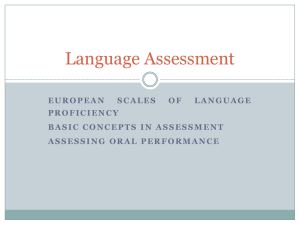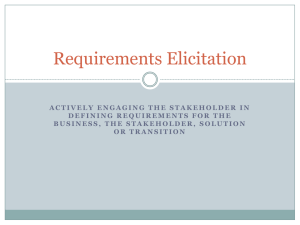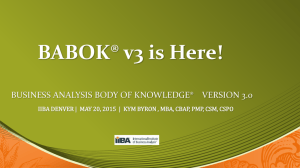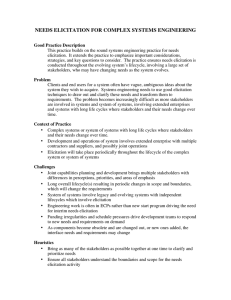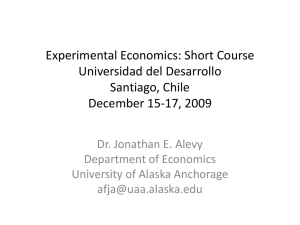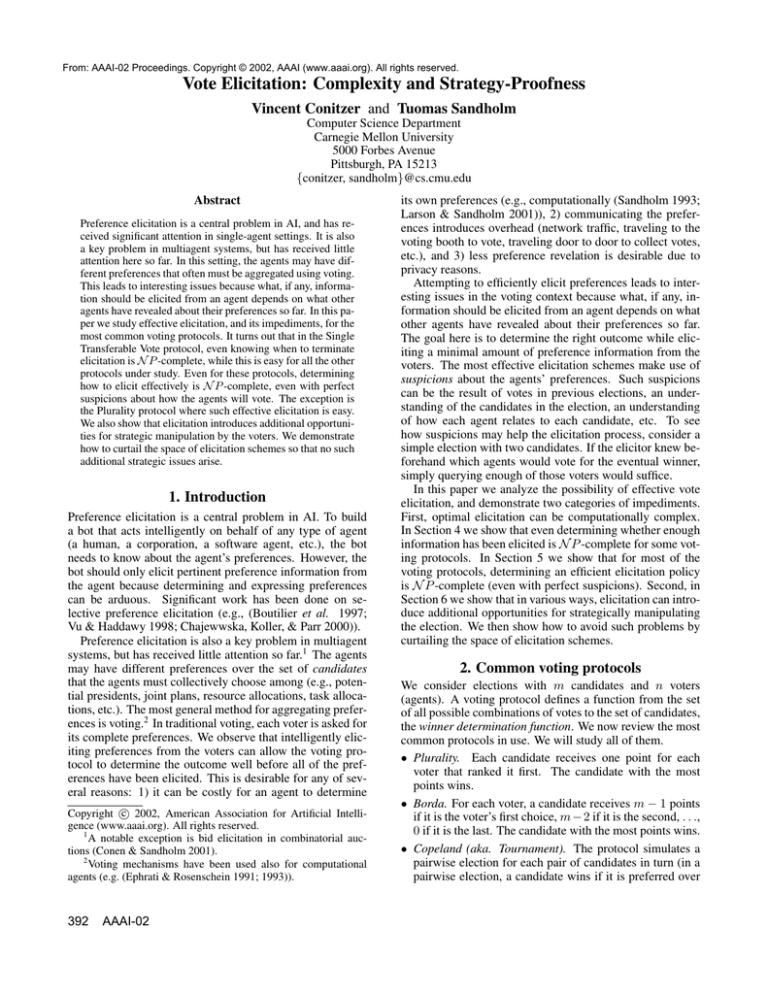
From: AAAI-02 Proceedings. Copyright © 2002, AAAI (www.aaai.org). All rights reserved.
Vote Elicitation: Complexity and Strategy-Proofness
Vincent Conitzer and Tuomas Sandholm
Computer Science Department
Carnegie Mellon University
5000 Forbes Avenue
Pittsburgh, PA 15213
{conitzer, sandholm}@cs.cmu.edu
Abstract
Preference elicitation is a central problem in AI, and has received significant attention in single-agent settings. It is also
a key problem in multiagent systems, but has received little
attention here so far. In this setting, the agents may have different preferences that often must be aggregated using voting.
This leads to interesting issues because what, if any, information should be elicited from an agent depends on what other
agents have revealed about their preferences so far. In this paper we study effective elicitation, and its impediments, for the
most common voting protocols. It turns out that in the Single
Transferable Vote protocol, even knowing when to terminate
elicitation is N P -complete, while this is easy for all the other
protocols under study. Even for these protocols, determining
how to elicit effectively is N P -complete, even with perfect
suspicions about how the agents will vote. The exception is
the Plurality protocol where such effective elicitation is easy.
We also show that elicitation introduces additional opportunities for strategic manipulation by the voters. We demonstrate
how to curtail the space of elicitation schemes so that no such
additional strategic issues arise.
1. Introduction
Preference elicitation is a central problem in AI. To build
a bot that acts intelligently on behalf of any type of agent
(a human, a corporation, a software agent, etc.), the bot
needs to know about the agent’s preferences. However, the
bot should only elicit pertinent preference information from
the agent because determining and expressing preferences
can be arduous. Significant work has been done on selective preference elicitation (e.g., (Boutilier et al. 1997;
Vu & Haddawy 1998; Chajewwska, Koller, & Parr 2000)).
Preference elicitation is also a key problem in multiagent
systems, but has received little attention so far.1 The agents
may have different preferences over the set of candidates
that the agents must collectively choose among (e.g., potential presidents, joint plans, resource allocations, task allocations, etc.). The most general method for aggregating preferences is voting.2 In traditional voting, each voter is asked for
its complete preferences. We observe that intelligently eliciting preferences from the voters can allow the voting protocol to determine the outcome well before all of the preferences have been elicited. This is desirable for any of several reasons: 1) it can be costly for an agent to determine
c 2002, American Association for Artificial IntelliCopyright gence (www.aaai.org). All rights reserved.
1
A notable exception is bid elicitation in combinatorial auctions (Conen & Sandholm 2001).
2
Voting mechanisms have been used also for computational
agents (e.g. (Ephrati & Rosenschein 1991; 1993)).
392
AAAI-02
its own preferences (e.g., computationally (Sandholm 1993;
Larson & Sandholm 2001)), 2) communicating the preferences introduces overhead (network traffic, traveling to the
voting booth to vote, traveling door to door to collect votes,
etc.), and 3) less preference revelation is desirable due to
privacy reasons.
Attempting to efficiently elicit preferences leads to interesting issues in the voting context because what, if any, information should be elicited from an agent depends on what
other agents have revealed about their preferences so far.
The goal here is to determine the right outcome while eliciting a minimal amount of preference information from the
voters. The most effective elicitation schemes make use of
suspicions about the agents’ preferences. Such suspicions
can be the result of votes in previous elections, an understanding of the candidates in the election, an understanding
of how each agent relates to each candidate, etc. To see
how suspicions may help the elicitation process, consider a
simple election with two candidates. If the elicitor knew beforehand which agents would vote for the eventual winner,
simply querying enough of those voters would suffice.
In this paper we analyze the possibility of effective vote
elicitation, and demonstrate two categories of impediments.
First, optimal elicitation can be computationally complex.
In Section 4 we show that even determining whether enough
information has been elicited is N P -complete for some voting protocols. In Section 5 we show that for most of the
voting protocols, determining an efficient elicitation policy
is N P -complete (even with perfect suspicions). Second, in
Section 6 we show that in various ways, elicitation can introduce additional opportunities for strategically manipulating
the election. We then show how to avoid such problems by
curtailing the space of elicitation schemes.
2. Common voting protocols
We consider elections with m candidates and n voters
(agents). A voting protocol defines a function from the set
of all possible combinations of votes to the set of candidates,
the winner determination function. We now review the most
common protocols in use. We will study all of them.
• Plurality. Each candidate receives one point for each
voter that ranked it first. The candidate with the most
points wins.
• Borda. For each voter, a candidate receives m − 1 points
if it is the voter’s first choice, m − 2 if it is the second, . . .,
0 if it is the last. The candidate with the most points wins.
• Copeland (aka. Tournament). The protocol simulates a
pairwise election for each pair of candidates in turn (in a
pairwise election, a candidate wins if it is preferred over
the other candidate by more than half of the voters). A
candidate gets 1 point if it defeats an opponent, 0 points if
it draws, and -1 points if it loses. The candidate with the
most points wins.
• Maximin. A candidate’s score in a pairwise election is the
number of voters that prefer it over the opponent. A candidate’s number of points is its lowest score in any pairwise
election. The candidate with the most points wins.
• Single Transferable Vote (STV). The winner determination
process proceeds in rounds. In each round, a candidate’s
score is the number of voters that rank it highest among
the remaining candidates, and the candidate with the lowest score drops out. The last remaining candidate wins.
(The name comes from the fact that a vote transfers from
its top remaining candidate to the next highest remaining
candidate when the former drops out.)
• Approval. Each voter labels each candidate as either approved or disapproved. The candidate that is approved by
the largest number of voters wins.
3. Definition of elicitation
We now formally define elicitation. We distinguish between
full elicitation, where the entire vote is elicited from every
agent; coarse elicitation, where upon querying an agent the
elicitor always asks for the agent’s entire vote; and fine elicitation where this need not be the case (for example, an agent
may be asked only what its most preferred candidate is). We
formalize elicitation policies as trees.
Definition 1 A coarse elicitation tree is a tree with the following properties:
• Each nonleaf node v is labeled with an agent av to be
queried.
• Each nonleaf node v has a child for each of the possible
votes of agent av .
• On each path from the root to a leaf, each agent occurs at
most once.
This tree determines how the elicitation will proceed for
any combination of votes by the agents. The elicitor starts at
the root. At each node, it queries the corresponding agent,
and subsequently moves to the child corresponding to the
obtained vote. We say the tree is valid for a protocol when
for each leaf, given the votes corresponding to the path from
the root to that leaf, the election’s outcome is determined.
Definition 2 A fine elicitation tree is a tree with the following properties:
• Each nonleaf node v is labeled with an agent av to be
queried, a subset of that agent’s possible votes Sv (the
ones consistent with av ’s responses so far), and a query
to be asked at that node. The query is given by a partition
T v of Sv ; once the query is answered, one element of T v
is the set of remaining consistent votes.
• Each nonleaf node v has a child for each element of T v .
• Given a nonleaf v, if av does not occur anywhere else on
the path from the root to v, then Sv is the set of all possible votes by av ; otherwise, consider the node w closest to
v on that path with av = aw . The element of T w corresponding to w’s child on the way to v must equal Sv .
• Each partition T x has at least 2 elements.
The interpretation is as follows. Each node still corresponds
to a query to the corresponding agent. A subset at a node is
the set of the agent’s possible votes that are consistent with
its responses so far. The partition indicates the various ways
in which this set may be reduced through the query.
We say the tree is valid for a protocol if for each leaf, the
outcome of the election is determined by the responses to
the queries on the path to that leaf. From now on, we only
consider valid trees.
Our model of elicitation is very general. It can be used to
represent intuitively reasonable queries as well as baroque
ones such as “Is it true that a is your most preferred candidate or that you prefer b to c?” (which could impose a
computational burden on the voter disproportionate to the
fact that it is only one query). Reasonable fine elicitation
policies will have some restriction on the types of T v allowed. Also, elicitation trees can be extremely large. Therefore, it can be unreasonable to expect the elicitor to use this
explicit representation for its elicitation policy, much less
to do an exhaustive search over these trees to find one that
minimizes the number of queries (for example, in the average case). Nevertheless, each well-defined elicitation policy
corresponds to an elicitation tree, and hence elicitation trees
are useful tools for analysis.
4. Hardness of terminating elicitation
Any sensible elicitation policy would need to be able to
determine when it can safely terminate. Otherwise, there
would be no benefit from elicitation. In this section, we first
show that for the STV protocol, it can be hard to determine
when the elicitation process can terminate. Then we show
that this is easy for the other voting protocols.
Definition 3 (ELICITATION-NOT-DONE) We are given
a set of votes S, a number t of votes that are still unknown,
and a candidate h. We are asked whether there is a way to
cast the t votes so that h will not win.3
In order to prove our hardness result, we make use of the
following result from the literature on the difficulty of manipulating an election.
Definition 4 (EFFECTIVE-PREFERENCE) We
are
given a set of votes S and a candidate c. One vote is not yet
known. Is there a way to cast the last vote that makes c win?
Theorem 1 (Known) For the STV protocol, EFFECTIVEPREFERENCE is N P -complete, even under the restriction
that at least one of the votes in S puts c in the top spot.
Proof: This was proven in (Bartholdi & Orlin 1991).
3
The problem of determining whether elicitation is done is actually the same problem as that of determining whether a coalition
of voters can make a candidate lose (Conitzer & Sandholm 2002).
This suggests a deep connection between the complexity of elicitation and that of manipulation.
AAAI-02
393
Theorem 2 For the STV protocol, ELICITATION-NOTDONE is N P -complete, even when t = 1.4
Proof: We reduce an arbitrary instance of EFFECTIVEPREFERENCE (with the restriction that at least one
of the votes in S puts c at the top) to an instance of ELICITATION-NOT-DONE as follows. In the
EFFECTIVE-PREFERENCE instance, let the candidate set
be CEP and the set of given votes SEP . Then, in our
ELICITATION-NOT-DONE instance, the candidate set is
CEP ∪ {h}. The known (elicited) set of votes S includes
all the votes from SEP , where h is appended to these votes
at the bottom – with the exception that one of the votes with
c at the top inserts h into the second place (right behind c).
Additionally, S includes |SEP | additional votes which place
h in the top spot and rank the other candidates in whichever
order. Finally, we set t = 1. We prove the instances are
equivalent by making the following observations. First, h
will always survive until the last round as it has almost half
the votes at the start. Second, if there exists a way for the
last vote to be cast such that h does not win the election, we
may assume that this vote places h at the bottom, since if
this vote ever transferred to h, h would win the election as it
would hold more than half the votes. Third, h will not win
the election if and only if it faces c in the last round (if c gets
eliminated, the vote that ranks h right below c would transfer to h and h would win the election; on the other hand, c is
ranked above h in all the votes that do not put h at the top, so
c would win the last round). Fourth, as long as c remains in
the election, the score of each candidate (besides h) in each
round before the last will be exactly the same as the corresponding score in the EFFECTIVE-PREFERENCE instance
(if we give the same value to the unknown vote in both instances). This follows from the fact that in this case, no vote
will ever transfer to or from h and the relevant votes are identical otherwise. It follows that the remaining vote can be cast
in such a way as to lead c to the final round if and only if the
remaining vote in the EFFECTIVE-PREFERENCE instance
can make c win the election. But then, by our third observation, the instances are equivalent.
Theorem 2 applies to both fine and coarse elicitation because in both the elicitor might end up in a situation where
it has elicited some votes completely and others not at all.
For the other protocols studied in this paper, determining whether elicitation can be terminated is easy. We have
constructed a polynomial-time algorithm for accomplishing
this, which applies to each of the other protocols. This
greedy algorithm (omitted due to limited space) is guaranteed to find t votes that make h not win if such t votes exist.
5. Hardness of deciding which votes to elicit
The elicitor could use its suspicions about how the agents
will vote to try to design the elicitation policy so that few
queries are needed. The suspicions could be represented by
a joint prior distribution over the agents’ votes. It is not too
4
In all N P -completeness proofs, we only prove N P -hardness
because proving that the problem is in N P is trivial.
394
AAAI-02
surprising that in this general setting, computational complexity issues arise with regard to optimal elicitation, because the number of probabilities in a general joint prior
distribution is (m!)n . Given that this is an impractically
large amount of information to generate (and to input into
an elicitor bot), it is reasonable to presume that the language
the elicitor uses to express its suspicions is not fully expressive. With such a restricted language, one might hope that
the optimal elicitation problem is tractable. However, this
turns out not to be the case! We show that if this language
even accomodates as little as degenerate distributions (all the
probability mass on a single vote), determining an optimal
coarse elicitation policy is hard. In other words, it is hard
even with perfect suspicions. We define the effective elicitation problem with perfect suspicions as follows:
Definition 5 (EFFECTIVE-ELICITATION) We
are
given a set of votes S and a number k. We are asked whether
there is a subset of S of size ≤ k that decides the election
constituted by the votes in S.
All the reductions in this section will be from 3-COVER.
Definition 6 (3-COVER) We are given a set U of size 3q
and a collection of subsets {Si }1≤i≤r of U (where r > q),
each of size 3. We are asked if there is a cover of U consisting
of q of the subsets.
Theorem 3 For the Approval protocol, EFFECTIVEELICITATION is NP-complete.
Proof: We reduce an arbitrary 3-COVER instance to the
following EFFECTIVE-ELICITATION instance. The candidate set is U ∪ {w}. The votes are as follows. For every
Si there is a vote approving Si ∪ {w}. Additionally, we
have r − 2q + 2 votes approving only {w}, for a total of
2r − 2q + 2 votes. Finally, we set k = r − q + 2. We claim
the problem instances are equivalent. First suppose there is
a 3-cover. Then we elicit all the votes that approve only w,
and the votes that correspond to sets in the cover, for a total
of k votes. Then w is r − q + 1 points ahead of all other
candidates, with only r − q votes remaining. Hence there is
an effective elicitation. On the other hand, suppose there is
no 3-cover. Then eliciting k votes will always give one of
the candidates in U at least 2 votes, so that w can be at most
r − q points ahead of this candidate. Hence, with r − q votes
remaining, the election cannot possibly be decided. So there
is no effective elicitation.
Theorem 4 For the Borda protocol,
ELICITATION is NP-complete.
EFFECTIVE-
Proof: We reduce an arbitrary 3-COVER instance to the
following EFFECTIVE-ELICITATION instance. The candidate set is U ∪ {w} ∪ B where B = {b1 , b2 , . . . , b64r2 }.
The votes are as follows. For each Si there is a vote
ranking the candidates (B/2, U − Si , B/2, Si , w),
where the occurrence of a set in the ranking signifies
all of its elements in whichever order, and B/2 signifies some subset of B containing half its elements.
Finally, there are 4r − 2q − 2 votes that rank the candidates
(w, b1 , . . . , b8r2 , u1 , . . . , u3q , b8r2 +1 , . . . , b64r2 ),
and another 4r − 2q − 2 that rank them
(w, b64r2 , . . . , b56r2 +1 , u3q , . . . , u1 , b56r2 , . . . , b1 ).
Let
g = 8r − 4q − 4, so that we have a total of g + r votes. Also,
let l = 64r2 + 3q, which is the number of points a candidate
gets for being in first place. Finally, we set k = g + q. We
claim the problem instances are equivalent. First suppose
there is a 3-cover. We elicit all the votes that put w on top,
and the votes that correspond to sets in the cover, for a total
of k votes. Even after eliciting just the ones that put w on
top, w is more than gl
2 ≥ 2rl (since g ≥ 4r) points ahead
of all the elements of B, and with only r votes remaining
it is impossible to catch up with w for anyone in B. For a
given element u of U , the votes that put w on top result in
a net difference of g(8r2 + 32 q + 12 ) points between w and
u. Of the q remaining elicited votes, precisely q − 1 placed
u ahead of half the elements of B, so the net difference in
points between w and u most favorable to u arising from
these would be −(q − 1)(32r2 + 3q). Finally, the vote that
put u below all the elements of b might contribute another
−3. Adding up all these net differences, we find that w is
ahead by at least 64r3 − 64qr2 + 12qr − 9q 2 + 4r − 5q − 5
points. On the other hand, the maximum number of points
u could gain on w with the remaining number of votes is
(r − q)(64r2 + 3q) = 64r3 − 64qr2 + 3qr − 3q 2 . It is
easily seen that the second expression is always smaller,
and hence w is guaranteed to win the election. So there is
an effective elicitation. On the other hand, suppose there
is no 3-cover. First, we observe that w will always win
the election - we have already shown that the votes that
put w on top guarantee it does better than any element of
B. For any element u of U , even if u is always placed
above all the other votes in U in the r votes corresponding
to the Si , it will still only gain r(32r2 + 3q) points on w
here, which is fewer than the g(8r2 + 32 q + 12 ) votes it
loses on w with the other votes (since g ≥ 4r). So we can
only hope to guarantee that w wins. Now, if there is an
elicitation that guarantees this, there is also one that elicits
all the g votes that put w on top, since replacing one of the
other votes with such a vote in the elicitation never hurts
w’s relative performance to another candidate. But in such
an elicitation, there is at least one candidate u in U that
is never ranked below all the elements of B in the q votes
elicited that put w at the bottom, since there is no 3-cover.
Let us investigate how many points w may be ahead of u
after eliciting these votes. Again, the votes that put w on top
result in a net difference of g(8r2 + 32 q + 12 ) points. In the
scenario most favorable to w, u would only gain q(32r2 +4)
points with the other q votes. Adding this up, w is ahead by
at most 64r3 − 64qr2 − 32r2 + 12qr − 6q 2 + 4r − 6q − 2
after the elicitation. The maximum number of points u
could gain on w with the remaining number of votes is still
64r3 − 64qr2 + 3qr − 3q 2 . It is easily seen that the second
expression is always larger, so we cannot guarantee that w
wins. So there is no effective elicitation.
The proofs are omitted due to limited space – the ideas are
similar to those used for the Approval and Borda protocols.
So far we have shown that determining an effective elicitation policy is hard for most of the voting protocols, and
that for the STV protocol even knowing when to terminate
is hard. The remaining protocol is Plurality, where it is easy
to elicit effectively given perfect suspicions (start eliciting
the winner’s votes first; if all of them have been elicited and
termination is still not possible, elicit votes in a round-robin
manner, one for each non-winning candidate (as long as it
has votes left), until the elicitation can terminate).
Theorem 5 For the Copeland protocol, EFFECTIVEELICITATION is NP-complete.
Theorem 6 For the Maximin protocol, EFFECTIVEELICITATION is NP-complete.
6.1. Coarse elicitation
6. Strategy-proofness of elicitation
We now turn to strategic issues that may be introduced into a
voting protocol by an elicitation process. Elicitation may reveal information about other agents’ votes to an agent, which
the agent may use to change its vote strategically. This is
undesirable for two reasons. First, it gives agents that are
elicited later an unfair advantage, causing the protocol to put
undue weight on their preferences. Second, it leads to less
truthful voting by the agents. This is undesirable because,
while voting protocols are designed to select a socially desirable candidate if agents vote truthfully, untruthful voting can
lead to a reduction in the social desirability of the outcome.
We demonstrate how such strategic issues may arise, and
then suggest avenues to circumvent them. However, these
avenues entail restricting the space of possible elicitations,
causing a reduction in the potential savings from elicitation.
To analyze strategic interactions, we need some tools
from game theory. To bring the voting setting into the framework of noncooperative game theory, we assume that agent
i’s preferences are defined by its type θi ; the agent gets utility ui (θi , c) if candidate c wins. We first define a game:
Definition 7 In a (normal form) game, we are given a set
of agents A; a set of types Θi for each agent i; a commonly
known prior distribution φ over Θ1 × Θ2 × . . . × Θ|A| ; a
set of strategies Σi for each agent i ∈ A; a set of outcomes
O (candidates in the case of voting); an outcome function
o : Σ1 × Σ2 × . . . × Σ|A| → O; and a utility function
ui : Θi × O → for each agent i ∈ A.
An agent knows its own type and can thus let its strategy
depend on its type according to a function fi : Θi → Σi .
We also need a notion of how an agent would play a game
strategically. This may depend on how others play.
Definition 8 A strategy function profile (f1 , f2 , . . . , f|A| )
is a Bayes-Nash equilibrium (BNE), if for each agent
i ∈ A, each θi ∈ Θi , and each strategy σi ∈ Σi ,
Eφ (ui (θi , o(f1 (θ1 ), f2 (θ2 ), . . . , fi (θi ), . . . , f|A| (θ|A| )))|θi )
≥ Eφ (ui (θi , o(f1 (θ1 ), f2 (θ2 ), . . . , σi , . . . , f|A| (θ|A| )))|θi )
(that is, each fi chooses, for each θi , a strategy that
maximizes i’s expected utility given the other players’ fj s).
We are now ready to state our results.
First we show that coarse elicitation may lead to strategic
manipulations when it reveals even slightly more than just
the fact that the agent is being elicited. Suppose that an agent
AAAI-02
395
can infer (e.g., from the time its type is elicited) how many
other agents have had their types elicited before it.
Theorem 7 In a coarse elicitation protocol, the following
properties can hold simultaneously:
• the protocol reveals no information to any agent except
that the agent’s type is elicited, and how many other
agents have had their types elicited before,
• the elicitation policy is optimized to finish as quickly as
possible on average given the distribution over the agents’
types (presuming the agents vote truthfully), and
• truthful voting is a BNE with full elicitation,
• truthful voting is not a BNE here. In particular, an agent
may have an incentive to vote differently depending on
how the other agents vote.
Proof: Consider an Approval election5 with 3 voters, i, j
and k, and 3 candidates, a, b, and c. Ties are broken randomly. Define truth-telling to mean approving all candidates
that give you utility ≥ 12 . Ties are broken randomly. Agents’
types are independent and the distributions are as follows.
With probability 12 , i has utility 1 for c, and utility 0 for a
and b; with probability 12 , it has utility 1 for a, and utility
0 for b and c. With probability 12 , j has utility 1 for c, and
utility 0 for a and b; with probability 12 , it has utility 1 for b
and c, and utility 0 for a. It is easy to see that truth-telling
is always an optimal strategy for i and j. With probability
1, k has utility 1 for a, 14 for b, and 0 for c. For k not to
approve c, and to approve a, is always optimal. In the full
elicitation case, should k approve b? If j has its first type,
it makes no difference. What if j has its second type? If i
has its first type, approving b leads to a tie between b and c,
and (expected) utility 18 ; not approving b leads to a victory
for c and utility 0. If i has its second type, approving b leads
to a tie between a and b and utility 58 ; not approving b leads
to a victory for a and utility 1. Hence, in the full elicitation
case, given that we are in a case where it matters whether
k approves b, approving b gives utility 38 , and not approving b gives utility 12 ; so not approving b is optimal. Thus,
truth-telling is a BNE here.
For the coarse elicitation case, we first design a policy
that is optimal with respect to the agents’ type distributions.
Query Q(l) asks voter l which candidates it approves. Then
an optimal elicitation protocol is: 1: first ask Q(i); 2a: if the
answer was {c}, ask Q(j); 2b: otherwise, ask Q(k); 3: if do
not know the winner yet, query the last voter.
To show optimality, assume the agents reply truthfully. If
i has its first type, and j its first, we finish after 2a, in 2 steps.
If i has its second type, we finish after 2b, in 2 steps. But
these are the only cases in which we can hope to finish in
only two steps, so the protocol is optimal.
Now, if k is queried second, this implies to it that i is of its
second type, and it is motivated to answer truthfully. But if i
5
We use the Approval protocol to demonstrate the negative results (Theorems 7 and 9) because 1) this demonstrates that these
strategic issues can occur even in a very simple protocol, and 2) the
protocol has a natural query type also for fine elicitation. However,
similar strategic issues arise in any reasonable protocol.
396
AAAI-02
is queried third, this implies to it that i is of its first type, and
j of its second type; and k is motivated to lie and approve b.
So truth-telling is not a BNE here.
However, if the elicitation reveals no information to the
agent being elicited (beyond the fact that the agent is being
elicited), then elicitation does not introduce strategic issues:
Theorem 8 Consider a coarse elicitation protocol which
manages to reveal nothing more to the agent than whether
or not his type is elicited. Then, the set of BNEs is the same
as in the corresponding full elicitation voting game.6
Proof: We claim that the normal form of the game is identical to that in the full elicitation setting; this implies the
theorem. Obviously, the Θi , the ui , and φ remain the same.
Now consider the Σi . Because no information is revealed
upon elicitation, the voter cannot condition its response on
anything but its type, as in the full elicitation case. That is,
each agent need only decide on the one vote that it will always cast if it is elicited. Hence, the strategy set of an agent
is simply the space of votes, as it is in the full elicitation case.
Finally, by our requirement that this elicitation produces the
same outcome as full elicitation, o is the same.
Future work includes designing an elicitation protocol
that reveals no information about how many agents have had
their types elicited so far. This seems difficult: most protocols at least betray the real time at which an agent is queried.
6.2. Fine elicitation
We now show that, unlike coarse elicitation, fine elicitation
can lead to additional strategic issues even if no unnecessary
information is revealed to the agents.
Theorem 9 In a fine elicitation protocol, the following
properties can hold simultaneously:
• the protocol reveals no information to any agent except
the queries to the agent and the order of those queries,
• the elicitation policy is optimized to finish as quickly as
possible on average given the distribution over the agents’
types (presuming the agents vote truthfully), and
• truthful voting is a BNE with full elicitation,
• truthful voting is not a BNE here. In particular, an agent
may have an incentive to vote differently depending on
how the other agents vote.
Proof: Consider an Approval election with 2 voters, i and
j, and 3 candidates, a, b, and c. Define truth-telling to mean
approving all candidates that give you utility ≥ 12 . Ties are
broken randomly. Agents’ types are independent and the
distributions are as follows. With probability 12 , i has utility
1 for b and c, and utility 0 for a; with probability 12 , it has
utility 1 for a and b, and utility 0 for c. It is easy to see
that truth-telling is always an optimal strategy for i. With
probability 1, j has utility 1 for a, 34 for b, and 0 for c. For
j not to approve c, and to approve a, is always optimal. In
6
For the game-theoretically inclined, we observe that some of
the BNEs in the coarse elicitation case are not subgame perfect.
These equilibria are unstable in the full elicitation case as well.
the full elicitation case, should j approve b? If i has its first
type, approving b leads to victory for b and a utility of 34 ; not
7
approving b leads to a 3-way tie and utility of 12
. If i has
its second type, approving b leads to a 2-way tie between a
and b and utility 78 ; not approving b leads to a victory for a
and utility 1. Hence, in the full elicitation case, approving
19
b gives utility 13
16 , and not approving b gives utility 24 ; so
approving b is optimal. Thus, truth-telling is a BNE here.
For the fine elicitation case, we first design a policy that
is optimal with respect to the agents’ type distributions. The
natural restriction here is to allow only the following type of
query: query Q(k, d) asks voter k if it approves candidate d.
Then an optimal elicitation protocol is: 1: first ask Q(i, a);
2a: if the answer was ’no’, ask Q(i, b); Q(j, b); Q(j, c); 2b:
otherwise, ask Q(j, a); Q(i, b); Q(j, b); Q(i, c). 3: if we do
not know the winner yet, ask the remaining queries.
To show optimality, assume the agents reply truthfully. If
i has its first type, we finish after 2a, in 4 steps; if i has its
second type, we finish after 2b, in 5 steps. This is optimal.
Now, if the first query to j is Q(j, b), this implies to it that
i is of its first type and it is motivated to answer truthfully.
But if the first query to j is Q(j, a), this implies to it that i is
of its second type; and i is motivated to lie and not approve
b. So truth-telling is not a BNE here.
Finally, we show that with a certain restriction on elicitation policies, we can guarantee that fine elicitation does not
introduce any strategic effects.
Definition 9 A fine elicitation policy is nondivulging if the
next query to an agent (if it comes) depends only on that
agent’s own responses to previous queries. (Whether or not
the next query is asked can depend on the agent’s and the
other agents’ responses to queries so far.)
Theorem 10 Consider a fine elicitation protocol which
manages to reveal nothing more to the agent than the queries
to the agent and the order of those queries. If the elicitation
policy is nondivulging, then the set of BNEs is the same as
in the full elicitation voting game.
Proof: We claim that the normal form of the game is identical to that in the full elicitation setting; this implies the theorem. Obviously, the Θi , the ui , and φ remain the same. Now
consider the Σi . Because the agent knows the first query to it
(if it comes), it can determine its response up front. The next
query (if it comes) can only depend on this response, so the
agent knows it, and can prepare a response to it up front as
well; and so on. So, in this setting, we can define the agent’s
strategy to be this entire sequence of responses. But this sequence correponds to exactly one vote in the full elicitation
case.7 Hence, the strategy set of an agent is simply the space
of votes, as it is in the full elicitation case. Finally, by our
requirement that this elicitation produces the same outcome
as full elicitation, o is the same.
While a restriction to nondivulging elicitation policies
avoids introducing additional strategic effects, it can reduce
the efficiency of elicitation.
7
By our definition of fine elicitation, no queries are asked that
enable an agent to express inconsistent (e.g., cyclical) preferences.
7. Conclusion and future research
Preference elicitation is a central problem in AI, and has received significant attention in single-agent settings. Preference elicitation is also a key problem in multiagent systems,
but has received little attention. The agents may have different preferences that often must be aggregated using voting.
This leads to interesting issues because what, if any, information should be elicited from an agent depends on what
other agents have revealed about their preferences so far.
In this paper we studied effective elicitation for the most
common voting protocols. It turned out that for the STV
protocol, even knowing when to terminate elicitation is N P complete, while this is easy for all the other protocols. Even
for these protocols, determining how to elicit effectively is
N P -complete, even with perfect suspicions about how the
agents will vote. The exception is the Plurality protocol
where such effective elicitation is easy.
Our results on strategy-proofness showed that in general
settings, elicitation introduces additional opportunities for
strategic manipulation of the election by the voters. We
demonstrated how to curtail the space of elicitation schemes
so that no such additional strategic issues arise.
Future research includes studying elicitation policies that
choose the right outcome with high probability rather than
with certainty. It also includes designing new voting protocols that combine the computational ease of elicitation in the
Plurality protocol with the expressiveness of the other protocols. Finally, it would be interesting to study specific fine
elicitation schemes in more detail.
Acknowledgments
This work was supported by the National Science Foundation under CAREER Award IRI-9703122, Grant IIS9800994, ITR IIS-0081246, and ITR IIS-0121678.
References
Bartholdi, III, J. J., and Orlin, J. B. 1991. Single transferable vote
resists strategic voting. Social Choice and Welfare 8(4):341–354.
Boutilier, C.; Brafman, R.; Geib, C.; and Poole, D. 1997. A
constraint-based approach to preference elicitation and decision
making. AAAI Spring Symposium: Qualitative Decision Theory.
Chajewwska, U.; Koller, D.; and Parr, R. 2000. Making rational
decisions using adaptive utility elicitation. AAAI, 363–369.
Conen, W., and Sandholm, T. 2001. Preference elicitation in
combinatorial auctions: Extended abstract. ACM Conference on
Electronic Commerce (ACM-EC), 256–259. More detailed description of the algorithms appeared in the IJCAI-2001 Workshop
on Economic Agents, Models, and Mechanisms, pp. 71–80.
Conitzer, V., and Sandholm, T. 2002. Complexity of manipulating
elections with few candidates. AAAI.
Ephrati, E., and Rosenschein, J. 1991. The Clarke tax as a consensus mechanism among automated agents. AAAI, 173–178.
Ephrati, E., and Rosenschein, J. S. 1993. Multi-agent planning as
a dynamic search for social consensus. IJCAI, 423–429.
Larson, K.; Sandholm, T. 2001. Bargaining with limited computation: Deliberation equilibrium.Artificial Intelligence132:183-217.
Sandholm, T. 1993. An implementation of the contract net protocol based on marginal cost calculations. AAAI, 256–262.
Vu, H.; Haddawy, P. 1998. Towards case-based preference elicitation: Similarity measures on preference structures. UAI, 193-201.
AAAI-02
397


